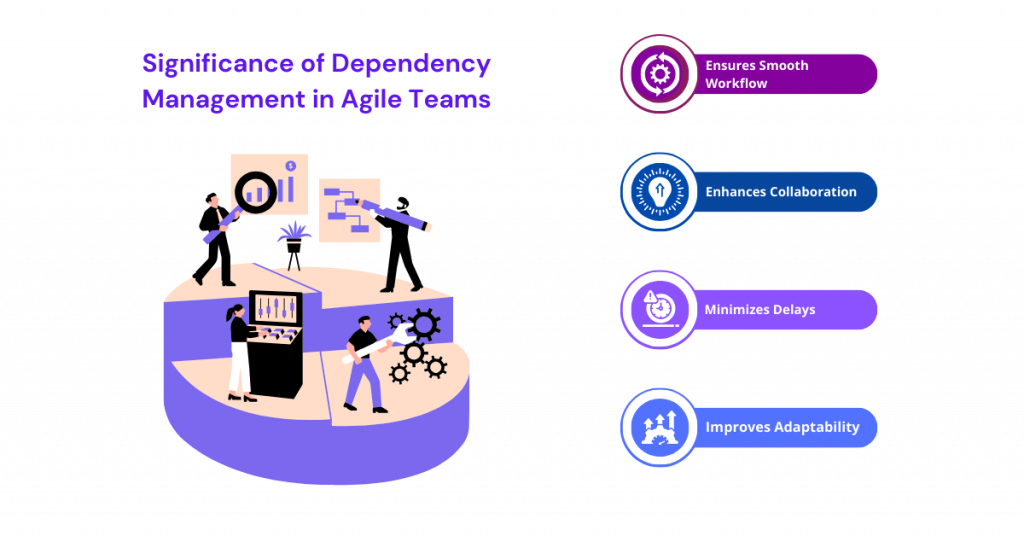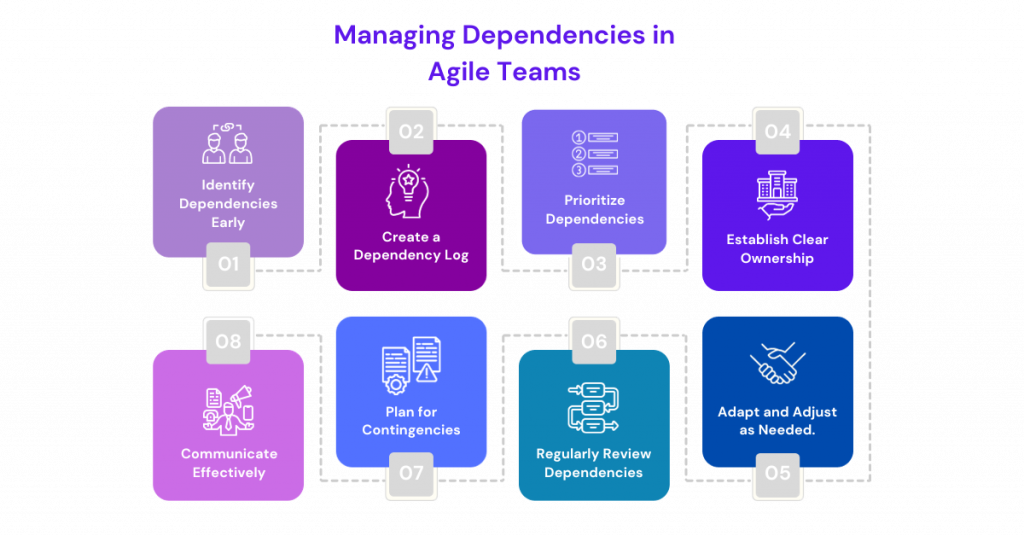Strategies To Manage Dependencies in Agile Teams

Agile teams are expected to be cross-functional, rapid, and able to deliver a solution to the customer independently.
To achieve an increase in value, teams frequently need to collaborate as a company grows and its product becomes more complicated.
Having teams depend on one another might create conflict because they are designed for independence, which slows projects.
Let’s further explore what dependencies are and how agile teams manage them efficiently.
What Are Dependencies?
Dependencies are actions that must exist for an agile team to accomplish a value upgrade but cannot be accomplished by the team independently.
Dependencies, if not appropriately managed, can cause delays in project execution.
The product backlog is the primary framework used in the scrum to guide the team’s strategy.
In general, the product backlog comprises activities (also known as user stories) with acceptance criteria.
The principle of handling external dependencies is based on the notion of independence. If a piece of work is self-contained, it has no dependents.
We should aim for this, but it is not often possible. Because cross-alignment and cross-vertical projects have benefits, we must prepare for and manage dependencies.
Why Do Dependencies Exist in Agile Teams?
You must be wondering why do dependencies exist in agile teams at all since dependencies reduce agility, and it breaks the whole purpose of it.
Cross-alignment Agile teams would make up the perfect organizational structure for an agile organization.
With no external dependencies, these teams might be able to produce value from beginning to end continuously. This is unrealistic, though.
Collaboration with other teams, departments, and people inside the business has advantages since most tasks—even those with the most agile design—include dependencies, at the very least within the team.
There are systemic dependencies, such as technological dependencies, in addition to these specific process dependencies.
This does not imply that dependencies are all made equal or that agile teams must always find a way to accommodate them.
Teams should endeavor to remove dependencies that are the product of poor or overly complicated organizational design.
But others are important for better collaboration, risk evaluation, or technological reasons.
Agile teams require extended checks and balances to guarantee that they present an excellent feasible solution.
An Agile team’s objective is to organize in cross-alignment agile teams, successfully “drawing out” unneeded dependencies rather than getting rid of all dependencies.
By using dependency mapping, improve your understanding of the dependencies between systems, procedures, and individuals.
Maintaining a culture of progress to get rid of pointless dependencies and determining how essential dependencies will impact deliverability by analyzing them is a must.
Lastly, you need to improve dependency management methods to lessen the disruption they cause.
Importance of Dependency Management in Agile Teams
If you don’t start managing project dependencies, your business can quickly go off the rails.
For instance, what if one project is delayed and you don’t understand it would over-allocate many of your squad members the following week unless other assignments are moved around?
What if a project cannot begin on time because the one it is reliant on was not completed on time?
Assume you’re constructing a property, and an inspector is set to sign off on all of the wirings at the month’s end.
However, according to your timeline, the electrician won’t complete the installation until the next month.
The inspector would turn up and charge you for their time, and you might lose the assessment if you did not recognize and manage this dependency.
When the wiring was finally finished, you’d have to reschedule them for four weeks.
Repeating examination would add expenditures to your construction, and if the inspector was not accessible at the time, it might have a substantial impact on the overall project.
It seems you couldn’t shut in the walls until you passed inspection, which would affect the drywallers, painters, and various other duties and resources.
As you may expect, this has a domino effect of escalating expenses and difficulties.

How To Manage Dependencies in Agile Teams?
Although dependency management can appear contradictory to agile, the truth is that dependencies are unavoidable in enterprises.
Regardless of how hard we try to make teams self-sufficient, coordinating efforts from outside teams will be required. Some things must be completed before others can begin.
There are technical requirements that must be met before operations can begin. These are just a few dependencies you and your team might encounter daily.
To handle dependencies, we should acknowledge that they are an inevitable component of any task and realize that they must not limit us.
We can regulate how dependencies impact task results by visualizing them, mapping them out, and creating their relationships.
Dependence is neither desirable nor evil. Your development’s success will be determined by how well you manage dependencies.
So, before your dependencies become the source of project bottlenecks and revisions, begin managing them carefully and using kanban to enhance how you handle dependencies.
1. Spend More Time on Planning and Scheduling
Invite the appropriate teams to plan reviews, meetings, consultations, or walkthroughs to understand your work, why it is essential, and how it matches the firm’s key objectives.
Show an effort in them and learn about their motivations and challenges.
Typically, a project manager collects time estimates for all tasks across various teams. They plan the numerous job items to be executed following the strategy.
This is the most prevalent and commonly used method in projects and teams.
2. Never Forget to Visualise Blockers
Drag Factors and Blockers Visualizing roadblocks is an integral part of dependency management.
If you find or come across a dependence while developing, apply blocker stickers to draw attention before focusing on unblocking.
Using blocker clustering, you can detect common internal or external blockers.
Determine which blockages may be averted long-term by lowering their effect or breaking them altogether.
3. Identify and Reduce Your Systematic Waiting Time
While an upstream team is dependent on a downstream team, the former will frequently demand tasks to be fulfilled by the downstream team.
This frequently emerges as a new job in the downstream team’s backlog.
Because of the downstream team’s various objectives and responsibilities, the job may sit in the backlog for an extended period.
Determine a method for measuring waiting time. This might be accomplished by logging blocked/unblocked data points on the upstream group’s blocker sticker.
Use this information to have more productive discussions with downstream product owners.
4. Never Forget to Visualise Blockers
Drag Factors and Blockers Visualizing roadblocks is an integral part of dependency management.
If you find or come across a dependence while developing, apply blocker stickers to draw attention before focusing on unblocking.
Using blocker clustering, you can detect common internal or external blockers.
Determine which blockages may be averted long-term by lowering their effect or breaking them altogether.
5. Inculcate Self-sufficiency in Your Teams
Build self-service capabilities within the team to eliminate dependency. This is based on the type of dependency.
For example, if you rely on a specific person’s skills, devote time and energy to growing those abilities throughout the team.
And, if you’re reliant on the downstream team and the occurrence of dependencies is severe, collaborate with them to create a means for you to self-serve and prevent having to pass it to them.
6. Sart Pulling Requests
Remember the old days when a whole app’s source code could be found in a single code repository?
Current methods of system architecture can result in a large number of repositories.
However, many companies demand tight ownership limits between teams for stated repos, preventing access.
This arrangement of repos to teams frequently leads to dependencies, which means that if you require a downstream team to help you to fix your reliance, you must file a request with that team and wait for them to complete the task.
Rather than doing so, many businesses now use an internal open source model.
Allow all developers access to all repositories. If they modify, they must submit a pull request.
The “owners” of that repo can then program review the modification and, if necessary, authorize it.
If you have the expertise to work on another codebase on which you rely, pull requests could help you decrease the effect of the reliance.

Benefits of Dependency Management Among Agile Teams
To build a realistic project timeline, you must understand how each task depends on others. The dependencies assist you in determining the proper execution of the jobs.
Beyond the project management software, you can set up and manage your schedule, but increasing dependencies make the job more difficult.
For example, if you’re working on excel to generate a gantt chart or timetable, what happens when a task doesn’t go well according to your plan?
This could involve starting late, finishing late, or rearranging the sequence and schedule of duties.
You will need to manually change every follow-on task in your calendar in each instance.
This takes time, and it raises the possibility that your timetable will contain errors.
When you use project management software to rearrange a job with dependencies, all dependent tasks are immediately adjusted.
This leads to a schedule that is better comprehensive and more dependable.
Conclusion:
Agile teams should not eliminate dependencies to become more agile but rather decrease complexity, enhance flow, and improve their capacity to anticipate how dependencies will affect their capacity to produce work.
It’s not necessary to launch dependency management as a company-wide program. It can start with only one team deciding to manage dependencies and expand from there carefully.
It’s an organizational ability like any other, and Agile teams get better at it the more they practice it.
That’s it for today. If you’re searching for solutions to problems like dependencies, depend on us! Try chisel’s free forever today and begin your journey with us.
